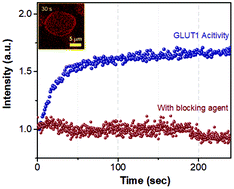Biologically-active unilamellar vesicles from red blood cells†
Abstract
We demonstrate a method to prepare giant unilamellar vesicles (GUVs) with biologically-active protein activity, by mixing erythrocyte (red blood cell) membrane extract with phospholipids and growing their mixture in a porous hydrogel matrix. This presents a pathway to retain protein biological activity without prior isolation and purification of the protein, though only the activity of the membrane protein GLUT1 is investigated to date. Using the cascade enzymatic reaction glucose oxidase and horseradish peroxidase to assay glucose concentration specifically within the GUV interior, we show that glucose is internalized by GLUT1 whereas adding cytochalasin B, a GLUT1 inhibitor, blocks glucose transport. The method presented here operates at biological ionic strength and is both simple and potentially generalizable.



 Please wait while we load your content...
Please wait while we load your content...